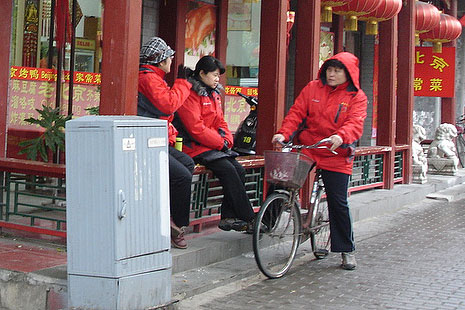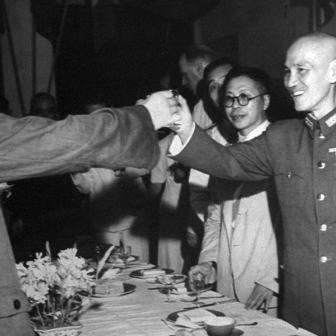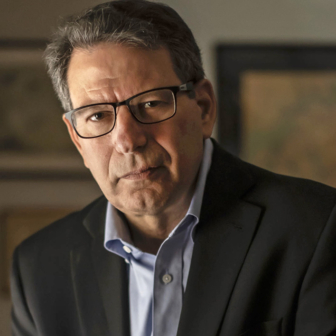What is the likelihood of seven men in China between the ages of fifty-seven and sixty-seven all having full heads of hair? Not great, according to a 2010 study of male-pattern baldness in China. The research, based on a sample of over 17,000 men from six different cities, revealed an incidence of 35 per cent and rising for androgenetic alopecia (common balding) in this age bracket. This is not as high as among Caucasians, but is consistent with the fact that the sight of bald and balding men is common in China.
On the basis of this statistic, observers should have been expecting that the seven members of the newly appointed Standing Committee of the Politburo of the Chinese Communist Party who emerged to public view on 15 November would include two or three with shiny pates. Alas for any such expectations: not a bald head in sight. Wang Qishan is getting there: his receding hairline suggests a degree of transparency well suited to his new position as head of the party’s anti-graft commission. And it’s true that Shanghai party boss Yu Zhengsheng, who at sixty-seven is the oldest of the group, has a rather high forehead. But for the rest, it is luxuriant black locks to a man.
What explains this statistical anomaly? One possible hypothesis is that the leadership group is different from the common herd. The abundance and vigorous growth of their tresses is simply consistent with and testament to their talents and vitality in other respects. Another reason could be that the selection process for the party leadership favours men with a lot of black hair. Or perhaps some of the seven have had hair transplants. (Wigs are also a possibility although not one supported by close visual inspection.)
This is not an easy question on which to purse armchair research. If men get their hair from their mother’s father, as common lore has it, a historical record is difficult to construct. We can readily find photos of Xi Jinping’s father (lots of hair at a comparable age) but not of his maternal grandfather. Yet it would appear that among Communist Party leaders, the 35 per cent–plus statistic was probably apparent until recently. We need look no further than the most obvious heads: Mao Zedong suffered frontal balding, president Liu Shaoqi had vertex balding, and defence minister Lin Biao balded dramatically at an early age (hence his trademark cap). Premier Zhou Enlai had hair, but even his was thinning in his old age.
The Reform Era reversed this pattern, although not immediately. Zhao Ziyang, forced off the political stage after soft-pedalling on the Tiananmen demonstrations in 1989, had very little hair. His replacement, Jiang Zemin, had quite a lot more, suggesting the beginning of a trend appropriate to the era of plenty in China. In keeping with the pattern of economic growth over the last ten years, the hair on the heads of leaders has become ever more luxuriant: swept up and back, or parted on the side, the glossy manes of president Hu Jintao and future president Xi Jinping, together with the more modest coiffures of their comrades, command a certain respect. Not since Ronald Reagan has America seen the like.
Television may be a factor encouraging this trend. The phenomenon of Politburo-meets-the-global-media is one of the more bizarre outcomes of the survival in China of a political organisation that in most other places has been outmoded. Chinese women watching the televised events of the morning of 15 November duly commented on the looks of the new party leaders. Incoming premier Li Keqiang got the guernsey for best-looking, but everyone agreed that Xi Jinping was excellent on TV; in striking contrast to Hu Jintao, he exudes geniality. (There are rumours that under his benign leadership the “harmonious society” of the Hu Jintao era is to be rebranded a “happy society.”)
The section of Chinese society least susceptible to androgenetic alopecia, women, was not represented on the podium. The party appears to be conscious of the problem of severe under-representation of women in government. A second woman has been moved up into the Politburo, increasing the percentage of women at this level to 8 per cent – still well below the percentage of party members who are women, which at around 18 per cent is also very low. One would hardly wish that more women could be participants in such a deeply self-interested, authoritarian organisation, liable as it is to corrupt all those who enter its embrace. Rather, these low figures are interesting as prima facie evidence either of strong networks of male patronage that work against high levels of female participation, or of the party’s failure to attract women as members, or both.
The under-representation of women in politics is an almost-global phenomenon, but with the creation of the new leadership group in China following so closely on the heels of the American election, it was difficult not to notice the contrast between the Chinese and American political systems in this respect. In the United States, as summed up by Maureen Dowd, “more women voted than men. Five women were newly elected to the Senate, and the number of women in the House will increase by at least three.” In China, women were visible as minority delegates in national costume, attendants within the hall, dancing girls and glamorous media representatives. But these were all young women. Members of the baby-boomer cohort, the sisters of the men standing on the stage, those who in their youth had been told that a woman could do whatever a man could do – they were hardly visible at all. •




